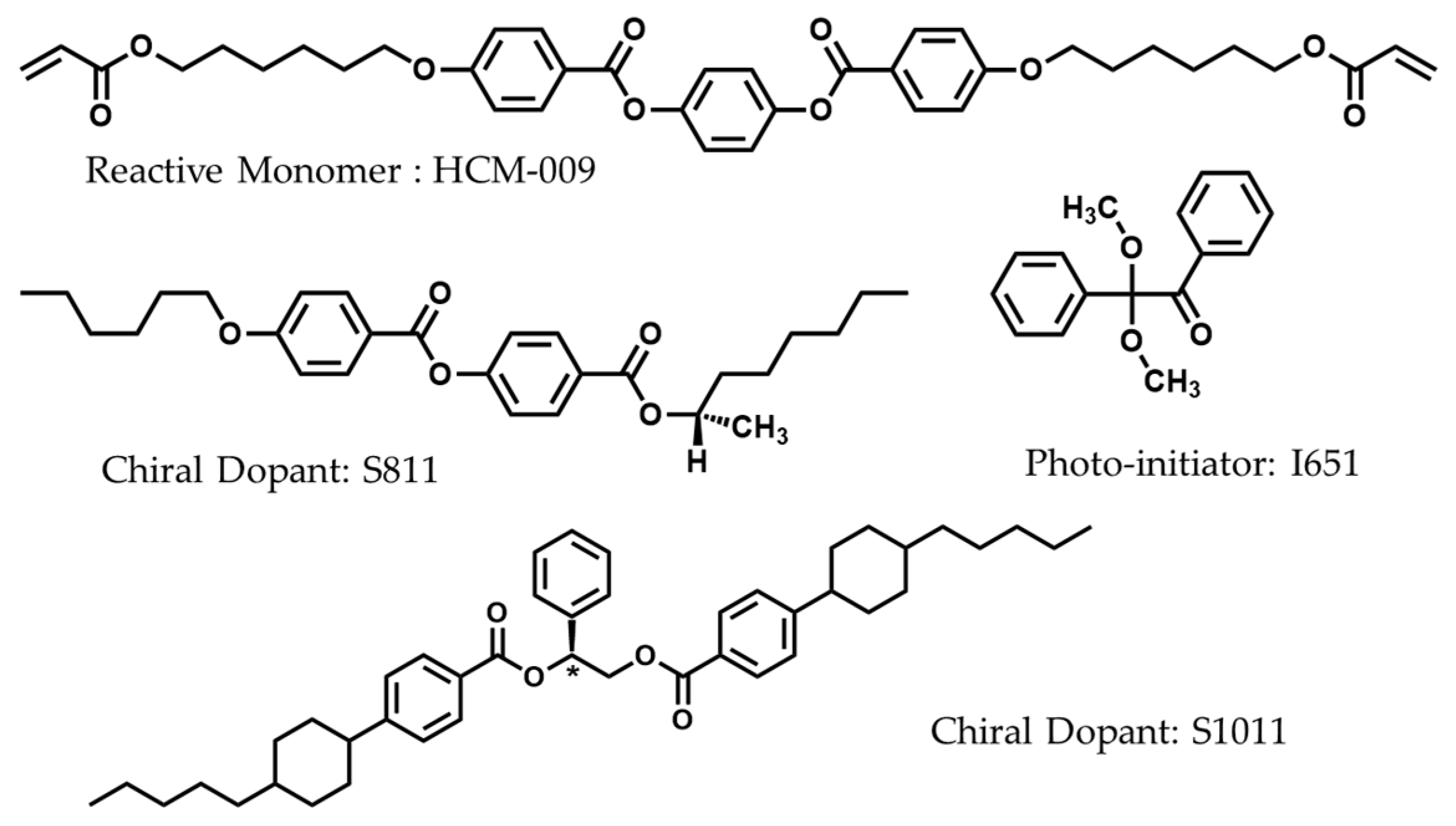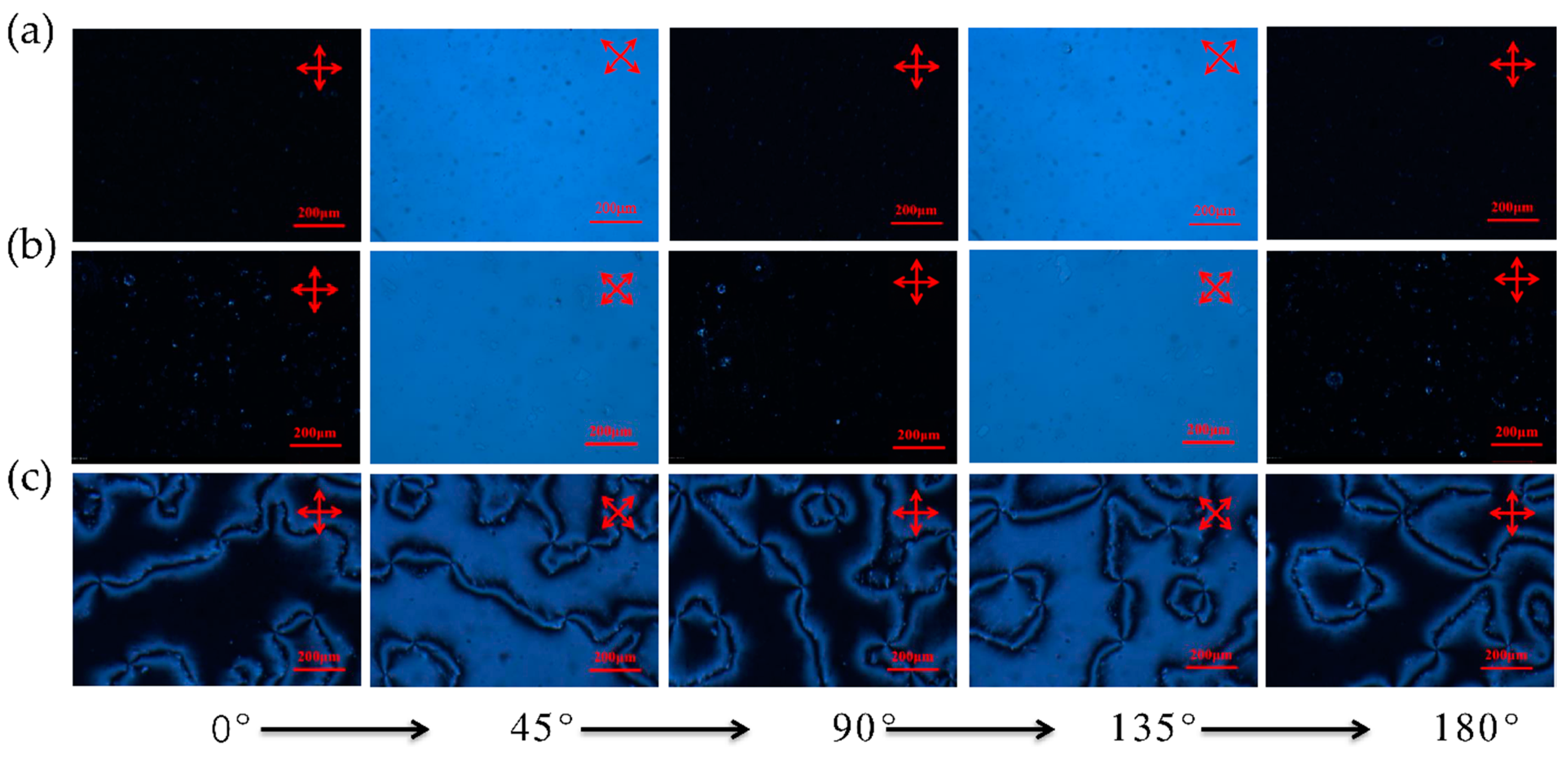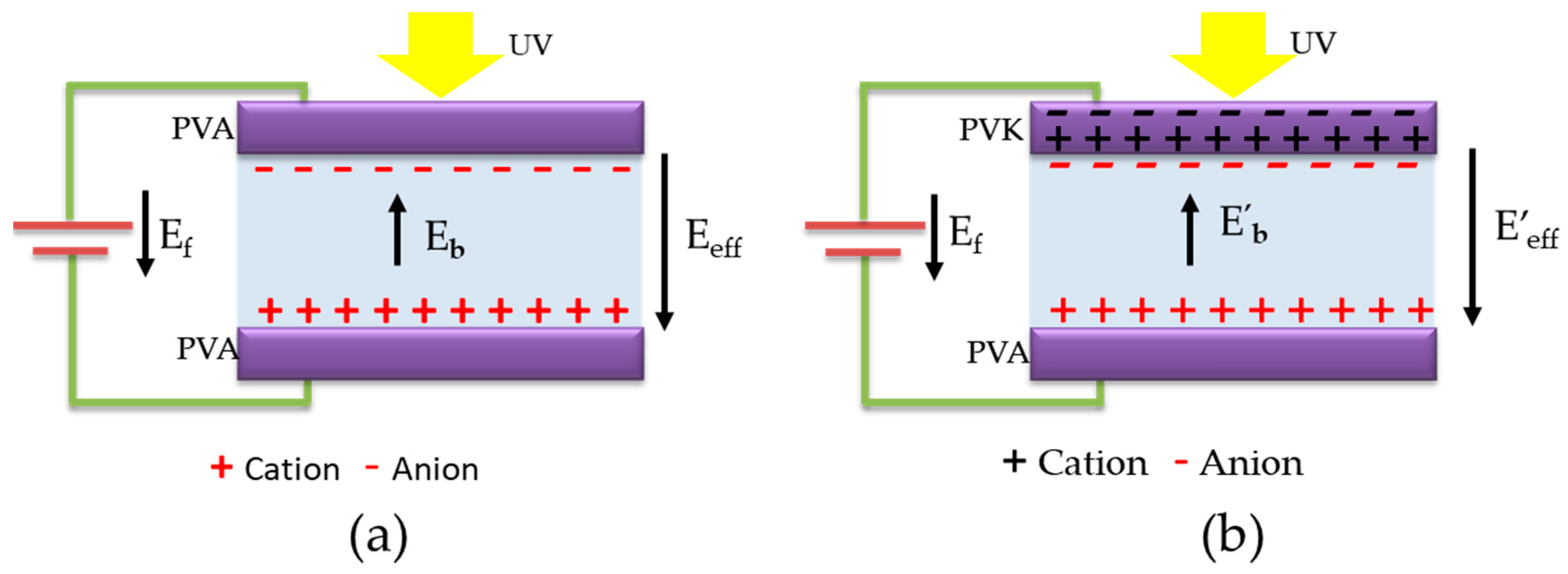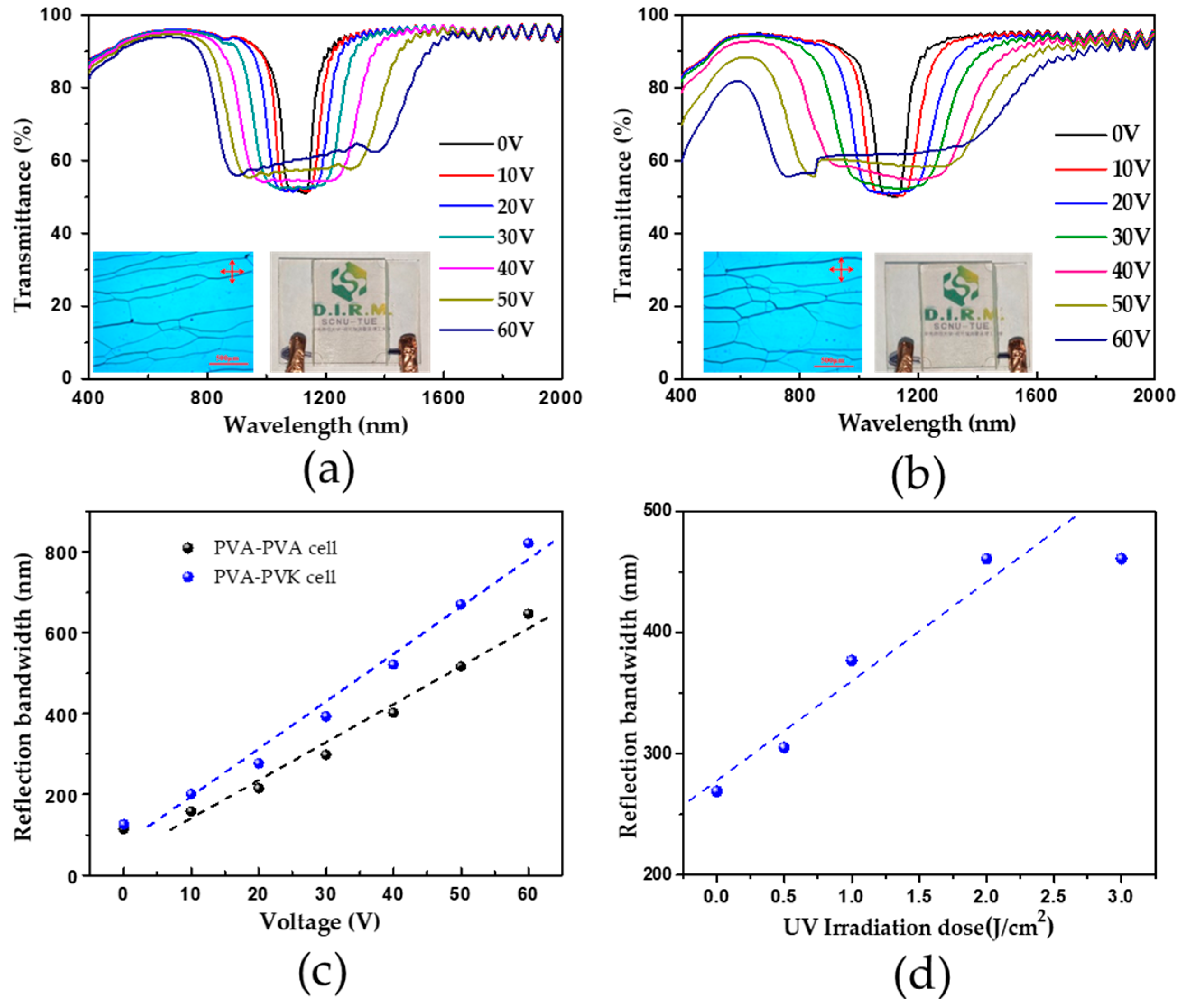Enhanced Bandwidth Broadening of Infrared Reflector Based on Polymer Stabilized Cholesteric Liquid Crystals with Poly(N-vinylcarbazole) Used as Alignment Layer
Abstract
:1. Introduction
2. Materials and Methods
3. Results and Discussion
4. Conclusions
Supplementary Materials
Author Contributions
Funding
Institutional Review Board Statement
Informed Consent Statement
Data Availability Statement
Acknowledgments
Conflicts of Interest
References
- Barile, C.J.; Slotcavage, D.J.; Hou, J.; Strand, M.T.; Hernandez, T.S.; McGehee, M.D. Dynamic Windows with Neutral Color, High Contrast, and Excellent Durability Using Reversible Metal Electrodeposition. Joule 2017, 1, 133–145. [Google Scholar] [CrossRef] [Green Version]
- Azens, A.; Granqvist, C. Electrochromic smart windows: Energy efficiency and device aspects. J. Solid State Electrochem. 2003, 7, 64–68. [Google Scholar] [CrossRef]
- Yeh, M.H.; Lin, L.; Yang, P.K.; Wang, Z.L. Motion-driven electrochromic reactions for self-powered smart window system. ACS Nano 2015, 9, 4757–4765. [Google Scholar] [CrossRef]
- Wang, J.; Zhang, L.; Yu, L.; Jiao, Z.; Xie, H.; Lou, X.W.; Sun, X.W. A bi-functional device for self-powered electrochromic window and self-rechargeable transparent battery applications. Nat. Commun. 2014, 5, 4921. [Google Scholar] [CrossRef] [Green Version]
- Piccolo, A. Thermal performance of an electrochromic smart window tested in an environmental test cell. Energy Build. 2010, 42, 1409–1417. [Google Scholar] [CrossRef]
- Vergaz, R.; Sánchez-Pena, J.-M.; Barrios, D.; Vázquez, C.; Contreras-Lallana, P. Modelling and electro-optical testing of suspended particle devices. Sol. Energy Mater. Sol. Cells 2008, 92, 1483–1487. [Google Scholar] [CrossRef] [Green Version]
- Ren, H.; Xu, S.; Wu, S.-T. Optical switch based on variable aperture. Opt. Lett. 2012, 37, 1421–1423. [Google Scholar] [CrossRef]
- Kim, Y.-B.; Park, S.; Hong, J.-W. Fabrication of flexible polymer dispersed liquid crystal films using conducting polymer thin films as the driving electrodes. Thin Solid Film. 2009, 517, 3066–3069. [Google Scholar] [CrossRef]
- Cupelli, D.; Pasquale Nicoletta, F.; Manfredi, S.; Vivacqua, M.; Formoso, P.; De Filpo, G.; Chidichimo, G. Self-adjusting smart windows based on polymer-dispersed liquid crystals. Sol. Energy Mater. Sol. Cells 2009, 93, 2008–2012. [Google Scholar] [CrossRef]
- Sutherland, R.L.; Tondiglia, V.P.; Natarajan, L.V. Electrically switchable volume gratings in polymer-dispersed liquid crystals. Appl. Phys. Lett. 1994, 64, 1074. [Google Scholar] [CrossRef]
- Sun, H.; Xie, Z.; Ju, C.; Hu, X.; Yuan, D.; Zhao, W.; Shui, L.; Zhou, G. Dye-Doped Electrically Smart Windows Based on Polymer-Stabilized Liquid Crystal. Polymers 2019, 11, 694. [Google Scholar] [CrossRef] [Green Version]
- Yan, X.; Liu, W.; Zhou, Y.; Yuan, D.; Hu, X.; Zhao, W.; Zhou, G. Improvement of Electro-Optical Properties of PSLC Devices by Silver Nanowire Doping. Appl. Sci. 2019, 9, 145. [Google Scholar] [CrossRef] [Green Version]
- Wang, J.; Meng, C.; Gu, Q.; Tseng, M.C.; Tang, S.T.; Kwok, H.S.; Cheng, J.; Zi, Y. Normally Transparent Tribo-Induced Smart Window. ACS Nano 2020, 14, 3630–3639. [Google Scholar] [CrossRef]
- Hikmet, R.A.M. From Liquid Crystalline Molecules to Anisotropic Gels. Mol. Cryst. Liq. Cryst. 1991, 198, 357–370. [Google Scholar] [CrossRef]
- Hu, X.; Zhang, X.; Yang, W.; Jiang, X.-F.; Jiang, X.; de Haan, L.T.; Yuan, D.; Zhao, W.; Zheng, N.; Jin, M.; et al. Stable and scalable smart window based on polymer stabilized liquid crystals. Appl. Ploym. 2020, 137, 48917. [Google Scholar] [CrossRef]
- Meng, C.; Tseng, M.C.; Tang, S.T.; Zhao, C.X.; Yeung, S.Y.; Kwok, H.S. Normally transparent smart window with haze enhancement via inhomogeneous alignment surface. Liq. Cryst. 2019, 46, 484–491. [Google Scholar] [CrossRef]
- Khandelwal, H.; Loonen, R.C.; Hensen, J.L.; Debije, M.G.; Schenning, A.P. Electrically switchable polymer stabilised broadband infrared reflectors and their potential as smart windows for energy saving in buildings. Sci. Rep. 2015, 5, 11773. [Google Scholar] [CrossRef] [PubMed]
- Khandelwal, H.; Timmermans, G.H.; Debije, M.G.; Schenning, A.P. Dual electrically and thermally responsive broadband reflectors based on polymer network stabilized chiral nematic liquid crystals: The role of crosslink density. Chem. Commun. 2016, 52, 10109–10112. [Google Scholar] [CrossRef] [PubMed]
- Hu, X.; de Haan, L.T.; Khandelwal, H.; Schenning, A.P.H.J.; Nian, L.; Zhou, G. Cell thickness dependence of electrically tunable infrared reflectors based on polymer stabilized cholesteric liquid crystals. Sci. China Mater. 2018, 61, 745–751. [Google Scholar] [CrossRef]
- Hu, X.; Zeng, W.; Zhang, X.; Wang, K.; Liao, X.; Jiang, X.; Jiang, X.-F.; Jin, M.; Shui, L.; Zhou, G. Pitch Gradation by Ion-Dragging Effect in Polymer-Stabilized Cholesteric Liquid Crystal Reflector Device. Ploymer 2020, 12, 96. [Google Scholar] [CrossRef] [PubMed] [Green Version]
- Khandelwal, H.; Debije, M.G.; White, T.J.; Schenning, A.P.H.J. Electrically tunable infrared reflector with adjustable bandwidth broadening up to 1100 nm. J. Mater. Chem. A 2016, 4, 6064–6069. [Google Scholar] [CrossRef]
- Hu, X.; Zeng, W.; Yang, W.; Xiao, L.; De Haan, L.T.; Zhao, W.; Li, N.; Shui, L.; Zhou, G. Effective electrically tunable infrared reflectors based on polymer stabilised cholesteric liquid crystals. Liq. Cryst. 2019, 46, 185–192. [Google Scholar] [CrossRef]
- Kitzerow, H.-S.; Bahr, C. Chirality in Liquid Crystals; Springer: New York, NY, USA, 2001. [Google Scholar]
- Meier, G. Handbook of liquid crystals. Von h. Kelker und r. Hatz. Verlag chemie, weinheim 1980. Xviii, 917 s., geb. Dm 420.00. Angew Chem. 1980, 92, 667–668. [Google Scholar] [CrossRef]
- Broer, D.J.; Lub, J.; Mol, G.N. Wide-band reflective polarizers from cholesteric polymer networks with a pitch gradient. Nature 1995, 378, 467–469. [Google Scholar] [CrossRef]
- Li, F.; Wang, L.; Sun, W.; Liu, H.; Liu, X.; Liu, Y.; Yang, H. Dye induced great enhancement of broadband reflection from polymer stabilized cholesteric liquid crystals. Polym. Adv. Technol. 2012, 23, 143–148. [Google Scholar] [CrossRef]
- Tondiglia, V.P.; Natarajan, L.V.; Bailey, C.A.; McConney, M.E.; Lee, K.M.; Bunning, T.J.; Zola, R.; Nemati, H.; Yang, D.-K.; White, T.J. Bandwidth broadening induced by ionic interactions in polymer stabilized cholesteric liquid crystals. Opt. Mater. Express 2014, 4, 1465–1472. [Google Scholar] [CrossRef]
- Lee, K.M.; Tondiglia, V.P.; Lee, T.; Smalyukh, I.I.; White, T.J. Large range electrically-induced reflection notch tuning in polymer stabilized cholesteric liquid crystals. J. Mater. Chem. C 2015, 3, 8788–8793. [Google Scholar] [CrossRef]
- Nemati, H.; Liu, S.; Zola, R.S.; Tondiglia, V.P.; Lee, K.M.; White, T.; Bunning, T.; Yang, D.K. Mechanism of electrically induced photonic band gap broadening in polymer stabilized cholesteric liquid crystals with negative dielectric anisotropies. Soft Matter 2015, 11, 1208–1213. [Google Scholar] [CrossRef]
- Yu, M.; Wang, L.; Nemati, H.; Yang, H.; Bunning, T.; Yang, D.-K. Effects of polymer network on electrically induced reflection band broadening of cholesteric liquid crystals. J. Polym. Sci. Part B 2017, 55, 835–846. [Google Scholar] [CrossRef]
- Min Lee, K.; Tondiglia, V.P.; Godman, N.P.; Middleton, C.M.; White, T.J. Blue-shifting tuning of the selective reflection of polymer stabilized cholesteric liquid crystals. Soft Matter 2017, 13, 5842–5848. [Google Scholar] [CrossRef] [PubMed]
- Hu, W.; Zhao, H.; Song, L.; Yang, Z.; Cao, H.; Cheng, Z.; Liu, Q.; Yang, H. Electrically Controllable Selective Reflection of Chiral Nematic Liquid Crystal/Chiral Ionic Liquid Composites. Adv. Mater. 2010, 22, 468–472. [Google Scholar] [CrossRef]
- Fuh, A.Y.-G.; Chen, K.N.; Wu, S.-T. Smart electro-optical iris diaphragm based on liquid crystal film coating with photoconductive polymer of poly(N-vinylcarbazole). Appl. Opt. 2016, 55, 6034–6039. [Google Scholar] [CrossRef] [PubMed]
- Law, K.Y. Organic photoconductive materials: Recent trends and developments. Chem. Rev. 1993, 93, 449–486. [Google Scholar] [CrossRef]
- Liu, G.; Zhang, B.; Chen, Y.; Zhu, C.-X.; Zeng, L.; Siu-Hung Chan, D.; Neoh, K.-G.; Chen, J.; Kang, E.-T. Electrical conductivity switching and memory effects in poly(N-vinylcarbazole) derivatives with pendant azobenzene chromophores and terminal electron acceptor moieties. J. Mater. Chem. 2011, 21, 6027–6033. [Google Scholar] [CrossRef]
- Hu, J.-W.; Chen, T.-A.; Jeng, S.-C. Broadband cholesteric liquid crystal devices with poly(N-vinyl carbazole) microstructures. Liq. Cryst. 2015, 42, 52–56. [Google Scholar] [CrossRef]
- Chen, Y.-D.; Fuh, A.Y.-G.; Cheng, K.-T. Particular thermally induced phase separation of liquid crystal and poly(N-vinyl carbazole) films and its application. Opt. Express 2012, 20, 16777–16784. [Google Scholar] [CrossRef]
- Ranjkesh, A.; Choi, J.-C.; Joo, K.-I.; Park, H.-W.; Zakerhamidi, M.S.; Kim, H.-R. Linear dichroism and order parameters of nematics doped with azo dyes. Mol. Cryst. Liq. Cryst. 2017, 647, 107–118. [Google Scholar] [CrossRef]
- Ghanadzadeh, A.; Shahzamanian, M.A.; Shoarinejad, S.; Zakerhamidi, M.S.; Moghadam, M. Guest–host interaction of some aminoazobenzene dyes doped in liquid crystalline matrix. J. Mol. Liq. 2007, 136, 22–28. [Google Scholar] [CrossRef]






| Sample | HCM009 (wt %) | Irg651 (wt %) | S1011 (wt %) | S811 (wt %) | HTW138200–100 (wt %) | HNG30400–200 (wt %) |
|---|---|---|---|---|---|---|
| Mixture 1 | 0 | 0 | 8.9 | 0 | 91.1 | 0 |
| Mixture 2 | 5 | 1 | 0 | 11.16 | 0 | 82.84 |
| Nematic Host | Dye | Alignment Layer | S |
|---|---|---|---|
| 5CB | RL-002 | PVA-PVA | 0.57 |
| PVA-PVK | 0.53 | ||
| PVK-PVK | 0.35 |
Publisher’s Note: MDPI stays neutral with regard to jurisdictional claims in published maps and institutional affiliations. |
© 2021 by the authors. Licensee MDPI, Basel, Switzerland. This article is an open access article distributed under the terms and conditions of the Creative Commons Attribution (CC BY) license (https://creativecommons.org/licenses/by/4.0/).
Share and Cite
Zhang, L.; Nie, Q.; Jiang, X.-F.; Zhao, W.; Hu, X.; Shui, L.; Zhou, G. Enhanced Bandwidth Broadening of Infrared Reflector Based on Polymer Stabilized Cholesteric Liquid Crystals with Poly(N-vinylcarbazole) Used as Alignment Layer. Polymers 2021, 13, 2238. https://doi.org/10.3390/polym13142238
Zhang L, Nie Q, Jiang X-F, Zhao W, Hu X, Shui L, Zhou G. Enhanced Bandwidth Broadening of Infrared Reflector Based on Polymer Stabilized Cholesteric Liquid Crystals with Poly(N-vinylcarbazole) Used as Alignment Layer. Polymers. 2021; 13(14):2238. https://doi.org/10.3390/polym13142238
Chicago/Turabian StyleZhang, Limin, Qiumei Nie, Xiao-Fang Jiang, Wei Zhao, Xiaowen Hu, Lingling Shui, and Guofu Zhou. 2021. "Enhanced Bandwidth Broadening of Infrared Reflector Based on Polymer Stabilized Cholesteric Liquid Crystals with Poly(N-vinylcarbazole) Used as Alignment Layer" Polymers 13, no. 14: 2238. https://doi.org/10.3390/polym13142238
APA StyleZhang, L., Nie, Q., Jiang, X.-F., Zhao, W., Hu, X., Shui, L., & Zhou, G. (2021). Enhanced Bandwidth Broadening of Infrared Reflector Based on Polymer Stabilized Cholesteric Liquid Crystals with Poly(N-vinylcarbazole) Used as Alignment Layer. Polymers, 13(14), 2238. https://doi.org/10.3390/polym13142238







